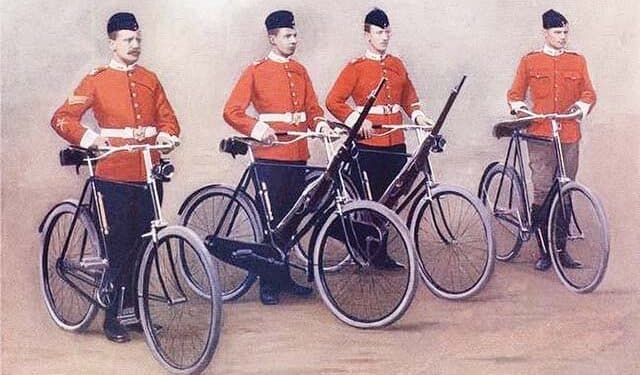In the late 19th century a new means of transportation was developed that could allow for, at the time, rapid movement of individuals, and it was seen by military planners as an alternative to the horse. It was the bicycle.
At the English Easter Maneuvers of 1891, the 26th Middlesex Cyclist Regiment demonstrated what is believed to be the first use of a machine gun fired by a cycle carriage. Military planners were impressed by the display, but there proved to be a rather significant issue with this concept: two bicycles mounted side-by-side with a platform for the Maxim gun in between. It simply weighed too much. At 96 pounds the bicycles of the era, with solid rubber tires and lacking the gears of today’s carbon fiber mountain bikes, were simply unable to pull the weight of the gun up even a slight incline. Two riders, even on level ground, would struggle to manage more than a few miles an hour. British designers tried to improve upon the design, and one concept included additional bikes that could aid by towing the twin-bike platform.
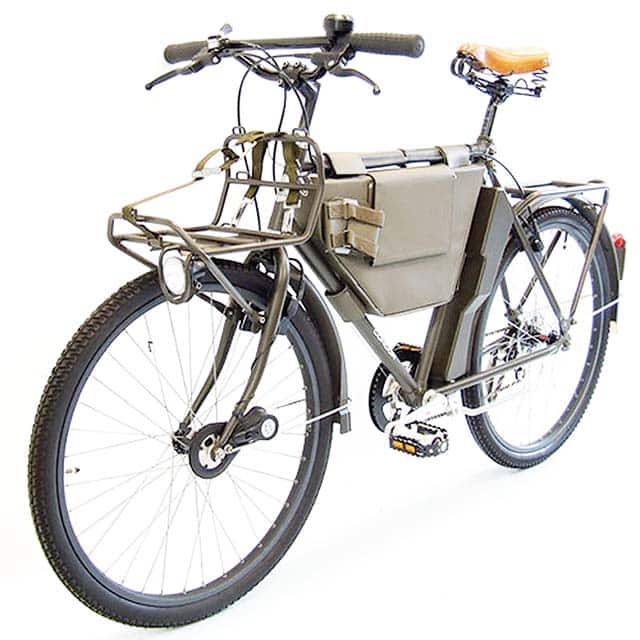
The Origin of Military Bicycles
Anyone who has visited parts of Europe, notably France, Italy and the Netherlands, can attest that these people love their bicycles. Bicycle racing is one of the most popular sports in Europe, following only football (soccer) in overall popularity. For many Europeans cycling is part of daily life as people commute to work, get to the store and when possible, get away from it all.
It is therefore not surprising that the bi-cycle also has a long and colorful history that includes service in various armies in Europe, and for that matter the world.
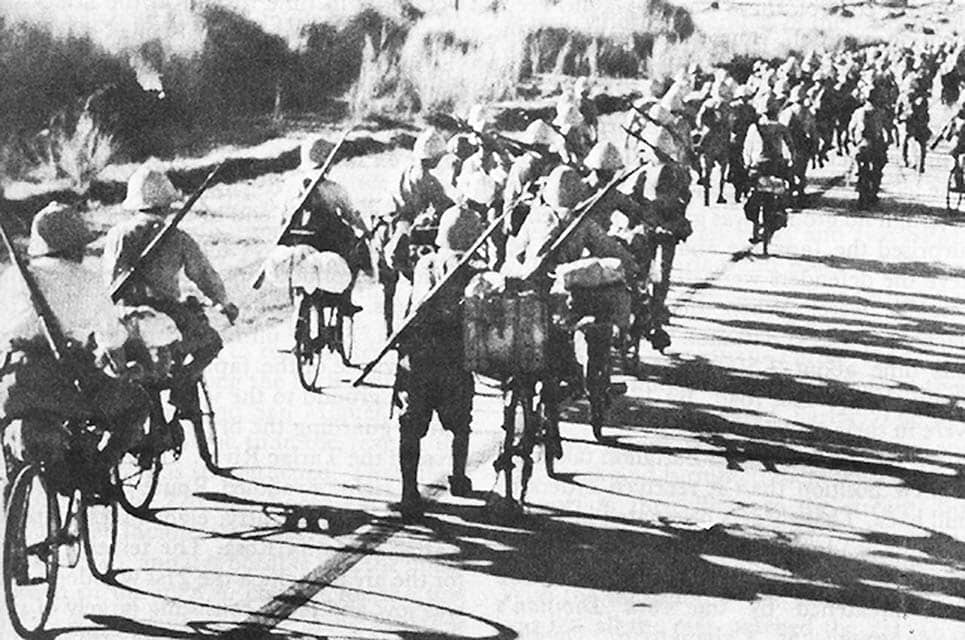
However, just as no one person, or persons, can lay claim to actually inventing the automobile, the same holds true for the bicycle. The first person generally credited with building a two-wheel device that would be the forerunner of the modern bicycle was German Baron Karl Von Drais, who in 1817 devised an in-line contraption that was propelled by the rider’s feet. This horse substitute, which was aimed at the well-to-do, didn’t catch on, however.
Other inventors and tinkerers attempted to create a human-driven machine, but it actually wasn’t until the 1860s that Frenchmen Pierre Michaux and Pierre Lallement introduced a pedal-driven system that would propel bicycle technology and subsequently the riders forward. While these early bicycles were actually awkward to ride, military planners saw a potential, and bicycles were employed by French scouts and dispatch riders during the Franco-Prussian War of 1870-1871.
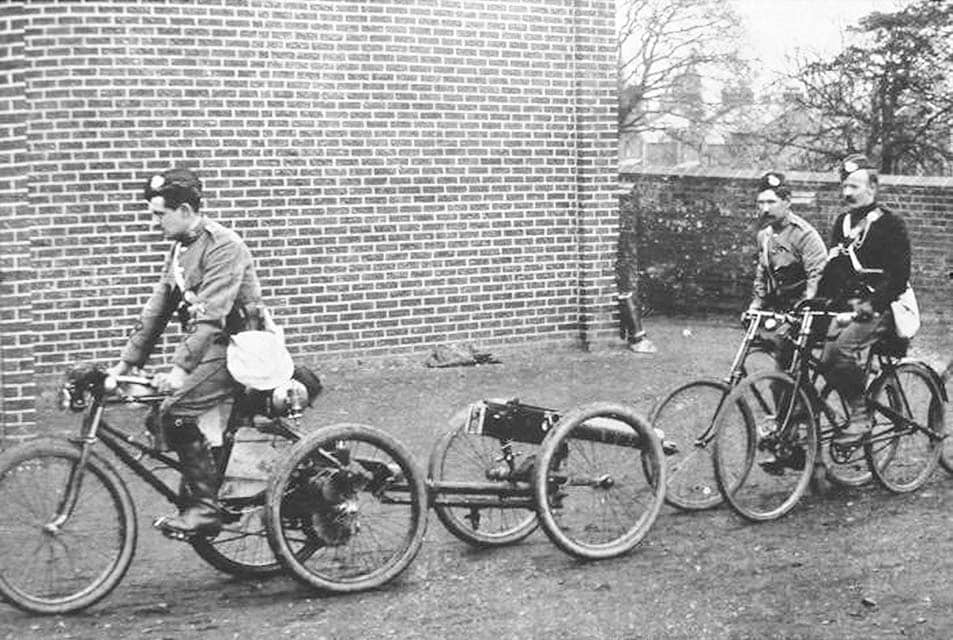
Just as technological advances were being made in the development of automatic weapons in the 1880s so too did the bicycle see significant innovation. English inventor John Kemp Starley built on this development and produced the world’s first successful “safety bicycle,” which was dubbed the “Rover.”
Released in 1885, its design would be recognizable even today. It featured equally sized front and back wheels, with the front being steerable and a chain drive to the rear wheel. Throughout Europe military planners saw a potential for scouts, but also for a new type of mobile infantry.
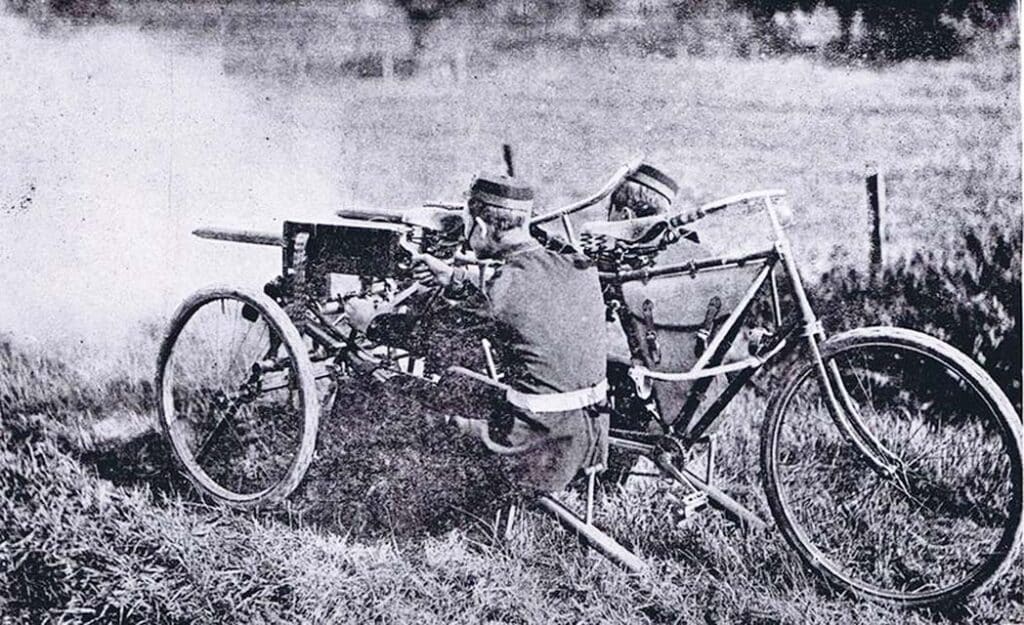
While technically a “tricycle,” this British design allowed two cyclists to transport two Maxim machine guns and ammunition. Weight remained an issue.
Across the Atlantic, a handful of American National Guard regiments experimented with bicycles. The First Signal Corps of the Connecticut National Guard formed the first military bicycle unit in 1891, when the bicycle was used by messengers and relay riders. Various challenges ensued including one that had a Connecticut National Guard cyclist prove he alone could deliver a message faster than an entire flag signaler team, while a relay team carried a single dispatch from Chicago to New York City in just four days and 13 hours, with much of it in rainy weather. A follow-up challenge brought a message from Washington, D.C. to Denver in just over six days!
The Bicycle and the Machine Gun Come Together
Military planners proved that the bicycle could be used to deliver messages, but the bicycle also found use for portable topographers and even telegraphers. In one case, a rider used his bike to study the grade of hills and other terrain to help commanders in the field determine if the land was traversable with cannons and wagons.
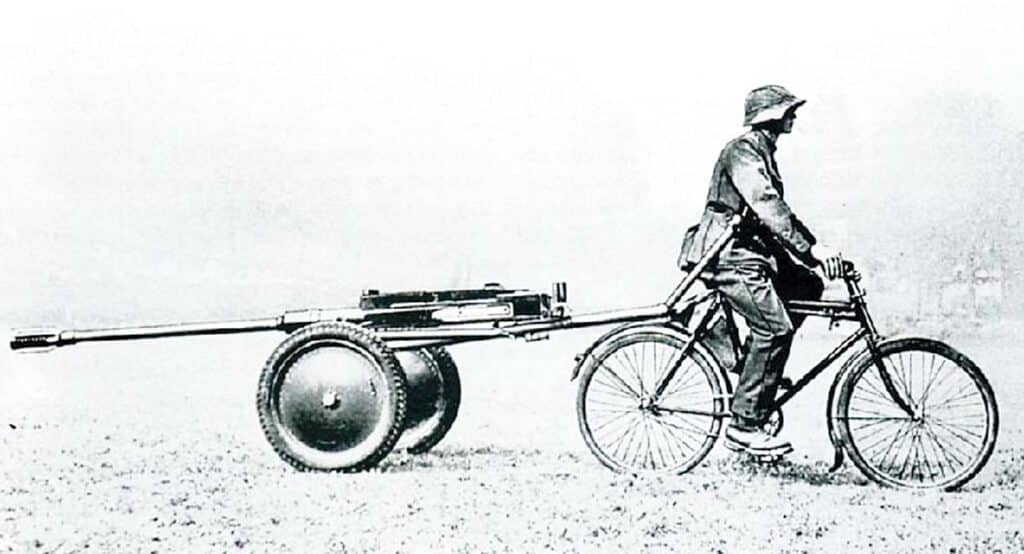
In addition to transporting machine guns, Swiss military planners considered how the bicycle would also transport small artillery pieces.
In the 1890s, multiple nations conducted field tests that included adding a sidecar mounted with early machine guns as well as side-mounted rifles that could be fired from the handlebars. During the Second Anglo-Boer War in South Africa, which began in 1899, the bicycle first had its baptism of fire when it was used by messengers, was adapted into portable stretch-ers and even used as a part of a specially devised two-man cycle to patrol the railroads. In the latter case about 20 were built for patrol work, however, none is believed to survive today.
One of the most notable concepts was produced just after the war ended, when the English company of Vickers & Sons & Maxim created a large, two-man tricycle that featured a platform for a pair of machine guns. More correctly a “tri-cycle” than “bicycle,” it featured three wheels and was designed to carry 1,000 cartridges along with two Vickers machine guns.
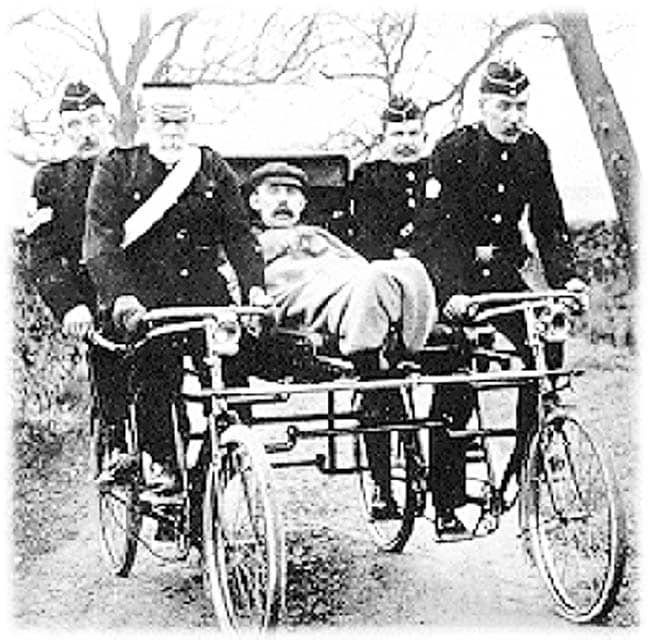
It wasn’t just guns that British military planners had in mind for the bicycle. During the Boer War the bicycle was also tested as a primitive ambulance!
This system allowed the two rear-facing guns to set up and fire simultaneously within mere minutes. However, the total weight was more than 375 pounds not including the riders! As with the earlier British design this meant it was almost impossible to pedal up a slope and instead had to be pushed. By removing one of the guns, tripod and ammunition, the tricycle’s weight was reduced to a far more manageable 126 pounds. The tests proved that the bicycle, at least in concept, could be used as a weapon’s platform.
The relative “success” of the bicycle caught the eye of American Albert Pope, who offered his own design which featured a Colt M1895 “potato digger” machine gun affixed to the front of the frame. It was of course impossible to fire while riding, and the weight of the gun seriously impacted the balance.
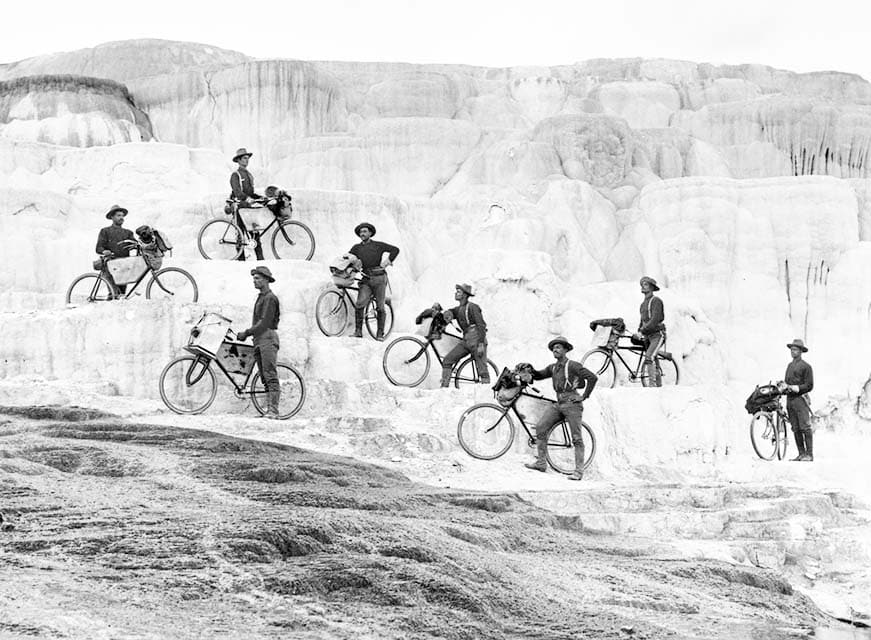
The American 25th Infantry were early pioneers and made up the core of the fledgling U.S. Army Bicycle Corps, which took part in maneuvers at Yellowstone Park in 1896.
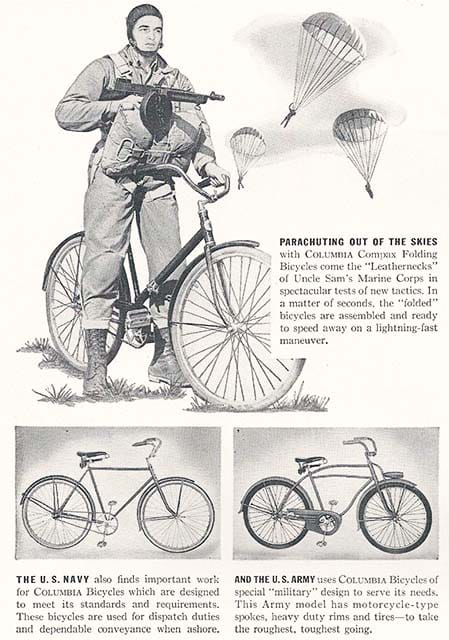
End of the Line
While designers continued to tinker with the designs, what truly resulted in the end of the line for the bicycle and machine gun were the trenches of the First World War. By that time the bicycle was employed by armies on both sides to help troops to get to the front line, but as the war bogged down into the hellish nightmare of trench warfare the two-wheel machines were relegated to rear echelon duty. Cycles were used to some degree by sharpshooters in less static areas as well as by scouts and, of course, dispatch riders.
A generation after the trench warfare of the First World War, the outbreak of war in Europe and Asia put the cycle back in the field. The German Army, even during its rapidly moving blitzkrieg, still relied on horse-drawn carriages to transport men and equipment, and bicycles also played a part.
Wartime shortages throughout World War II also resulted in many nations utilizing the bicycle to save on fuel. During the invasion of Malaysia, there were thousands of Japanese soldiers rolling towards Singapore on bicycles. As rubber was in short supply, it is reported that Japanese soldiers learned to ride on the rims when the tires went flat and couldn’t be repaired.
Ironically, the nation that is most associated with military bikes is one that stayed neutral throughout both world wars, Switzerland. That nation’s Bicycle Infantry was introduced in 1905 and only phased out in 2001; for nearly 100 years the bikes that the mountain nation used were known for their high quality and equally high durability. While Switzerland experimented with mounting machine guns on bikes over the years, like most other nations it found that the bicycle was best used as a tool for infantry.
In the end it was the introduction of motorized vehicles that signaled the end of the line for the bicycle and the machine gun.
| This article first appeared in Small Arms Review V23N6 (JUNE/JULY 2019) |



